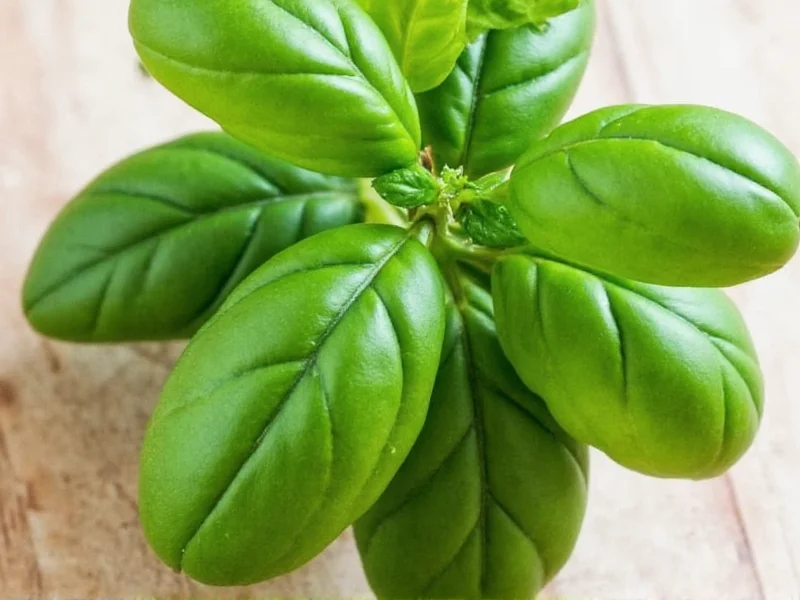1/4 cup fresh basil equals approximately 1 tablespoon dried basil. This 3:1 conversion ratio (fresh to dried) accounts for the concentrated flavor in dried herbs due to moisture removal during the drying process.
When substituting dried basil for fresh in recipes, understanding the precise conversion is essential for balanced flavor. The standard culinary guideline states that dried herbs are generally three times more potent than their fresh counterparts because the drying process concentrates their essential oils and flavors while removing moisture.
The Science Behind Herb Conversion Ratios
Herb conversion isn't arbitrary—it's rooted in food science. Fresh basil contains approximately 90% water. When basil is dried, this moisture evaporates, leaving behind a more concentrated form of the herb's essential oils and flavor compounds. This concentration effect explains why you need significantly less dried basil to achieve similar flavor intensity.
For precise cooking measurements, remember this fundamental rule: 1 tablespoon of dried basil equals 3 tablespoons (1/4 cup) of fresh basil. This ratio applies consistently across most recipes, whether you're preparing Italian sauces, pesto, or Mediterranean dishes.
Practical Application in Cooking
When adapting recipes that call for fresh basil but you only have dried available, follow these practical steps:
- Identify the fresh basil measurement in your recipe
- Divide the amount by three to determine the dried equivalent
- For 1/4 cup fresh basil, use exactly 1 tablespoon dried basil
- Consider adding dried herbs earlier in the cooking process to allow time for rehydration
- Taste and adjust seasoning before serving
Chefs often recommend adding dried herbs during the cooking process rather than at the end, as they need time to rehydrate and release their flavors fully. Fresh herbs, by contrast, are typically added toward the end of cooking to preserve their delicate flavor and vibrant color.
| Herb | 1 Tbsp Fresh Equals | 1 Tbsp Dried Equals | Special Considerations |
|---|---|---|---|
| Basil | 1 tsp dried | 3 tsp (1 tbsp) fresh | Best added early in cooking when dried |
| Oregano | 1/4 tsp dried | 1 1/4 tsp fresh | Dried oregano is significantly stronger |
| Parsley | 1/2 tsp dried | 1 1/2 tsp fresh | Fresh preferred for garnish |
| Rosemary | 1/4 tsp dried | 3/4 tsp fresh | Very potent when dried |
| Thyme | 1/4 tsp dried | 3/4 tsp fresh | Similar potency difference as rosemary |
When Substitution Ratios May Vary
While the 3:1 ratio works for most applications involving 1 4 cup fresh basil is how much dried conversions, several factors can influence the ideal substitution:
- Herb quality: Older dried herbs lose potency over time
- Storage conditions: Properly stored dried herbs maintain strength longer
- Recipe type: Delicate dishes may require more precise adjustments
- Personal preference: Some cooks prefer slightly stronger or milder herb flavors
For the most accurate results when converting how much dried basil equals 1/4 cup fresh, consider your dried herbs' age. If they've been stored for more than six months, you might need to increase the amount slightly as volatile oils diminish over time.
Optimizing Flavor with Dried Basil
To maximize flavor when using dried basil as a substitute for fresh:
- Rehydrate first: Mix dried basil with a small amount of warm water or broth before adding to dishes
- Add early: Incorporate dried herbs during cooking to allow flavors to develop
- Crush between fingers: Releases more essential oils before adding to recipes
- Store properly: Keep dried herbs in airtight containers away from light and heat
Remember that while dried basil provides convenience and longer shelf life, fresh basil offers a brighter, more complex flavor profile. When possible, use fresh basil for finishing dishes and dried for cooking processes that require longer simmering times.
Common Conversion Mistakes to Avoid
Many home cooks make these errors when converting between fresh and dried herbs:
- Using equal measurements (1:1 ratio) instead of the proper 3:1 ratio
- Adding dried herbs at the same stage as fresh herbs
- Not accounting for the age of dried herbs
- Overcompensating when substituting, resulting in overpowering flavors
- Confusing volume measurements with weight measurements
For the specific conversion of 1/4 cup fresh basil to dried measurement, always start with 1 tablespoon dried basil, then adjust to taste after the dish has cooked for at least 15 minutes. This approach prevents the common mistake of over-seasoning, which cannot be corrected once made.











 浙公网安备
33010002000092号
浙公网安备
33010002000092号 浙B2-20120091-4
浙B2-20120091-4